https://github.com/fossasia/visdom
A flexible tool for creating, organizing, and sharing visualizations of live, rich data. Supports Torch and Numpy.
https://github.com/fossasia/visdom
Last synced: 7 days ago
JSON representation
A flexible tool for creating, organizing, and sharing visualizations of live, rich data. Supports Torch and Numpy.
- Host: GitHub
- URL: https://github.com/fossasia/visdom
- Owner: fossasia
- License: apache-2.0
- Created: 2017-01-25T17:59:45.000Z (almost 9 years ago)
- Default Branch: master
- Last Pushed: 2024-05-30T16:53:59.000Z (over 1 year ago)
- Last Synced: 2025-12-07T12:19:27.150Z (11 days ago)
- Language: Python
- Homepage:
- Size: 34.9 MB
- Stars: 10,198
- Watchers: 181
- Forks: 1,147
- Open Issues: 120
-
Metadata Files:
- Readme: README.md
- Contributing: CONTRIBUTING.md
- License: LICENSE
- Code of conduct: CODE_OF_CONDUCT.md
- Authors: AUTHORS
Awesome Lists containing this project
- StarryDivineSky - fossasia/visdom
- awesome-list - Visdom - A flexible tool for creating, organizing, and sharing visualizations of live, rich data. Supports Torch and Numpy. (Data Visualization / Data Management)
README

Creating, organizing & sharing visualizations of live, rich data. Supports Python.
Jump To: Setup, Usage, API, Customizing, Contributing, License
Visdom aims to facilitate visualization of (remote) data with an emphasis on supporting scientific experimentation.
Broadcast visualizations of plots, images, and text for yourself and your collaborators.
Organize your visualization space programmatically or through the UI to create dashboards for live data, inspect results of experiments, or debug experimental code.
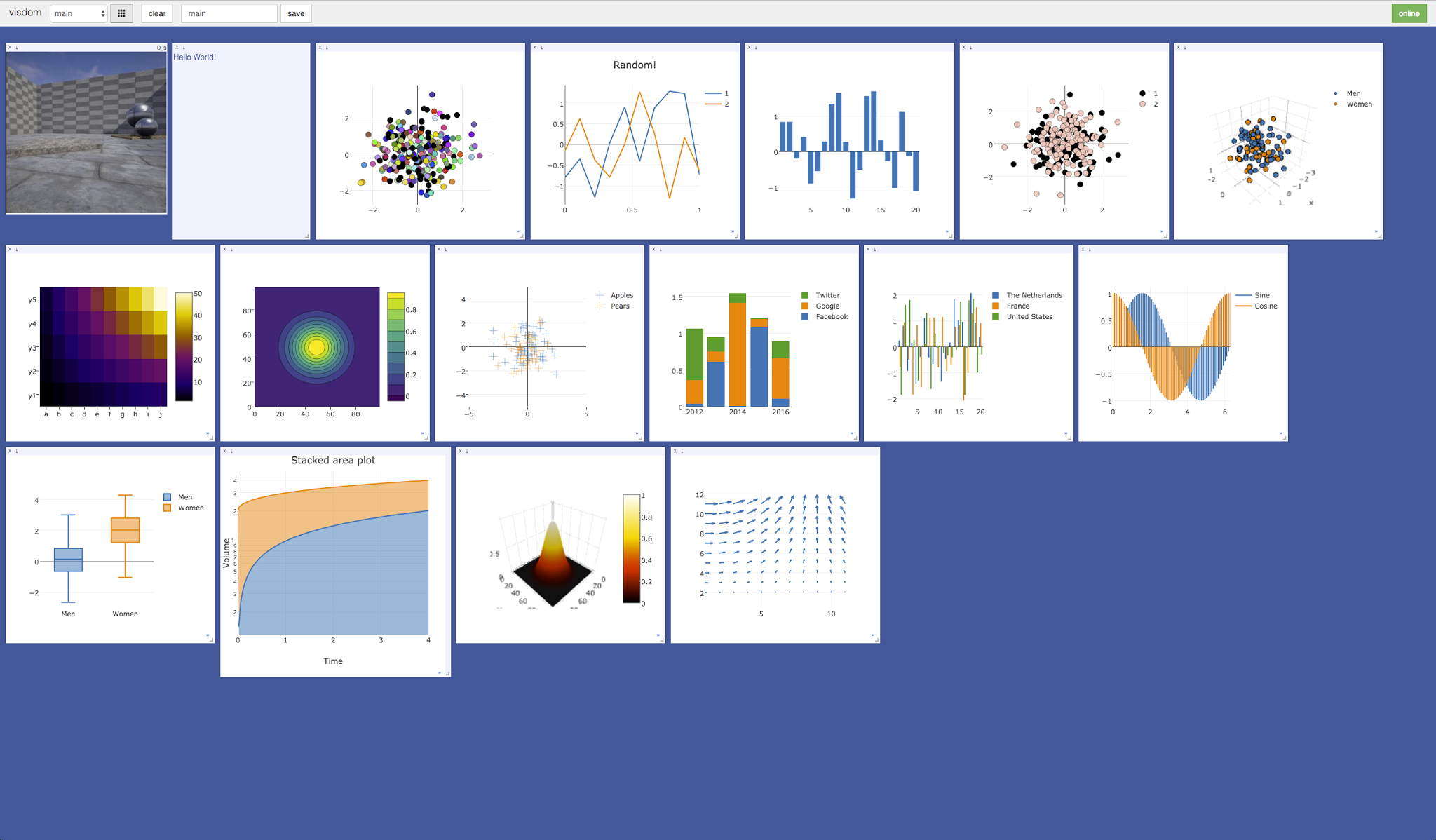


## Concepts
Visdom has a simple set of features that can be composed for various use-cases.
Windows

The UI begins as a blank slate – you can populate it with plots, images, and text. These appear in windows that you can drag, drop, resize, and destroy. The windows live in `envs` and the state of `envs` is stored across sessions. You can download the content of windows – including your plots in `svg`.
> **Tip**: You can use the zoom of your browser to adjust the scale of the UI.
Callbacks
The python Visdom implementation supports callbacks on a window. The demo shows an example of this in the form of an editable text pad. The functionality of these callbacks allows the Visdom object to receive and react to events that happen in the frontend.
You can subscribe a window to events by adding a function to the event handlers dict for the window id you want to subscribe by calling `viz.register_event_handler(handler, win_id)` with your handler and the window id. Multiple handlers can be registered to the same window. You can remove all event handlers from a window using `viz.clear_event_handlers(win_id)`. When an event occurs to that window, your callbacks will be called on a dict containing:
- `event_type`: one of the below event types
- `pane_data`: all of the stored contents for that window including layout and content.
- `eid`: the current environment id
- `target`: the window id the event is called on
Additional parameters are defined below.
Right now the following callback events are supported:
1. `Close` - Triggers when a window is closed. Returns a dict with only the aforementioned fields.
2. `KeyPress` - Triggers when a key is pressed. Contains additional parameters:
- `key` - A string representation of the key pressed (applying state modifiers such as SHIFT)
- `key_code` - The javascript event keycode for the pressed key (no modifiers)
3. `PropertyUpdate` - Triggers when a property is updated in Property pane
- `propertyId` - Position in properties list
- `value` - New property value
4. `Click` - Triggers when Image pane is clicked on, has a parameter:
- `image_coord` - dictionary with the fields `x` and `y` for the click coordinates in the coordinate frame of the possibly zoomed/panned image (*not* the enclosing pane).
Editable Plot Parameters
Use the top-right *edit*-Button to inspect all parameters used for plot in the respective window.
The visdom client supports dynamic change of plot parameters as well. Just change one of the listed parameters, the plot will be altered on-the-fly.
Click the button again to close the property list.
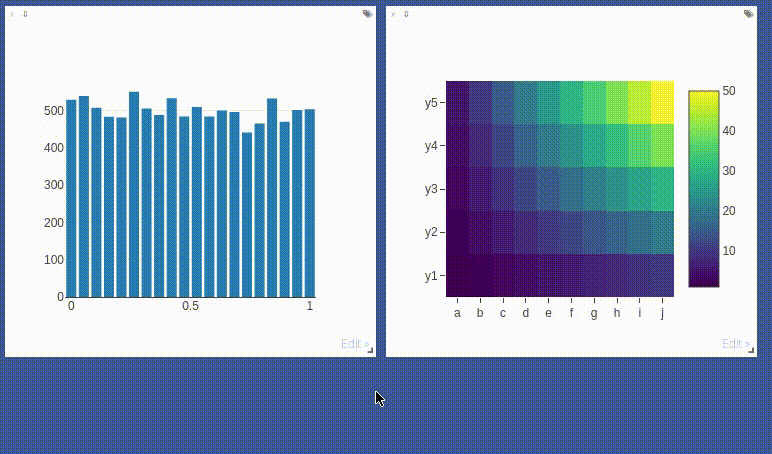
Environments

You can partition your visualization space with `envs`. By default, every user will have an env called `main`. New envs can be created in the UI or programmatically. The state of envs is chronically saved. Environments are able to keep entirely different pools of plots.
You can access a specific env via url: `http://localhost.com:8097/env/main`. If your server is hosted, you can share this url so others can see your visualizations too.
Environments are automatically hierarchically organized by the first `_`.
#### Selecting Environments
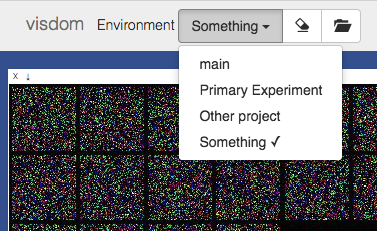
From the main page it is possible to toggle between different environments using the environment selector. Selecting a new environment will query the server for the plots that exist in that environment. The environment selector allows for searching and filtering for the new enironment.
#### Comparing Environments
From the main page it is possible to compare different environments using the environment selector. Selecting multiple environments in the check box will query the server for the plots with the same titles in all environments and plot them in a single plot. An additional compare legend pane is created with a number corresponding to each selected environment. Individual plots are updated with legends corresponding to "x_name" where `x` is a number corresponding with the compare legend pane and `name` is the original name in the legend.
> **Note**: The compare envs view is not robust to high throughput data, as the server is responsible for generating the compared content. Do not compare an environment that is receiving a high quantity of updates on any plot, as every update will request regenerating the comparison. If you need to compare two plots that are receiving high quantities of data, have them share the same window on a singular env.
#### Clearing Environments
You can use the eraser button to remove all of the current contents of an environment. This closes the plot windows for that environment but keeps the empty environment for new plots.
#### Managing Environments
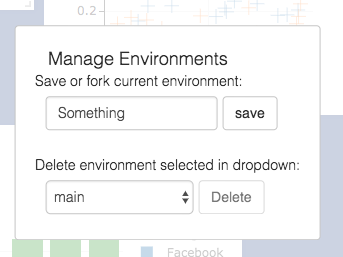
Pressing the folder icon opens a dialog that allows you to fork or force save the current environment, or delete any of your existing environments. Use of this feature is fully described in the **State** section.
>**Env Files:**
>Your envs are loaded upon request by the user, by default from `$HOME/.visdom/`. Custom paths can be passed as a cmd-line argument. Envs are removed by using the delete button or by deleting the corresponding `.json` file from the env dir. In case you want the server to pre-load all files into cache, use the flag `-eager_data_loading`.
State
Once you've created a few visualizations, state is maintained. The server automatically caches your visualizations -- if you reload the page, your visualizations reappear.
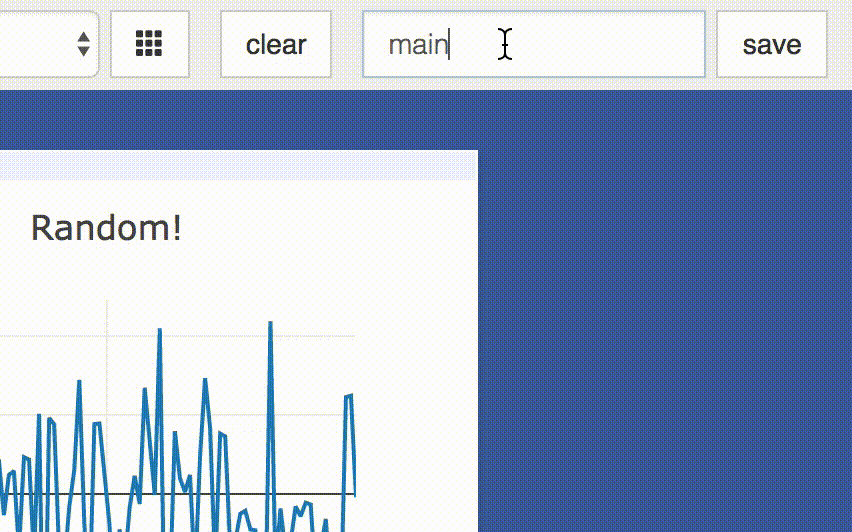
* **Save:** You can manually do so with the `save` button. This will serialize the env's state (to disk, in JSON), including window positions. You can save an `env` programmatically.
This is helpful for more sophisticated visualizations in which configuration is meaningful, e.g. a data-rich demo, a model training dashboard, or systematic experimentation. This also makes them easy to share and reuse.
* **Fork:** If you enter a new env name, saving will create a new env -- effectively **forking** the previous env.
> **Tip**: Fork an environment before you begin to make edits to ensure that your changes are saved seperately.
### Filter
You can use the `filter` to dynamically sift through windows present in an env -- just provide a regular expression with which to match titles of window you want to show. This can be helpful in use cases involving an env with many windows e.g. when systematically checking experimental results.

> **Note**: If you have saved your current view, the view will be restored after clearing the filter.
>
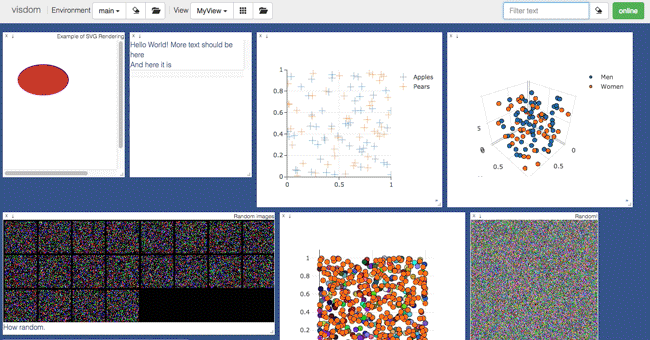
### Views

It is possible to manage the views simply by dragging the tops of windows around, however additional features exist to keep views organized and save common views. View management can be useful for saving and switching between multiple common organizations of your windows.
#### Saving/Deleting Views
Using the folder icon, a dialog window opens where views can be forked in the same way that envs can be. Saving a view will retain the position and sizes of all of the windows in a given environment. Views are saved in `$HOME/.visdom/view/layouts.json` in the visdom filepath.
> **Note**: Saved views are static, and editing a saved view copies that view over to the `current` view where editing can occur.
#### Re-Packing
Using the repack icon (9 boxes), visdom will attempt to pack your windows in a way that they best fit while retaining row/column ordering.
> **Note**: Due to the reliance on row/column ordering and `ReactGridLayout` the final layout might be slightly different than what might be expected. We're working on improving that experience or providing alternatives that give more fine-tuned control.
#### Reloading Views
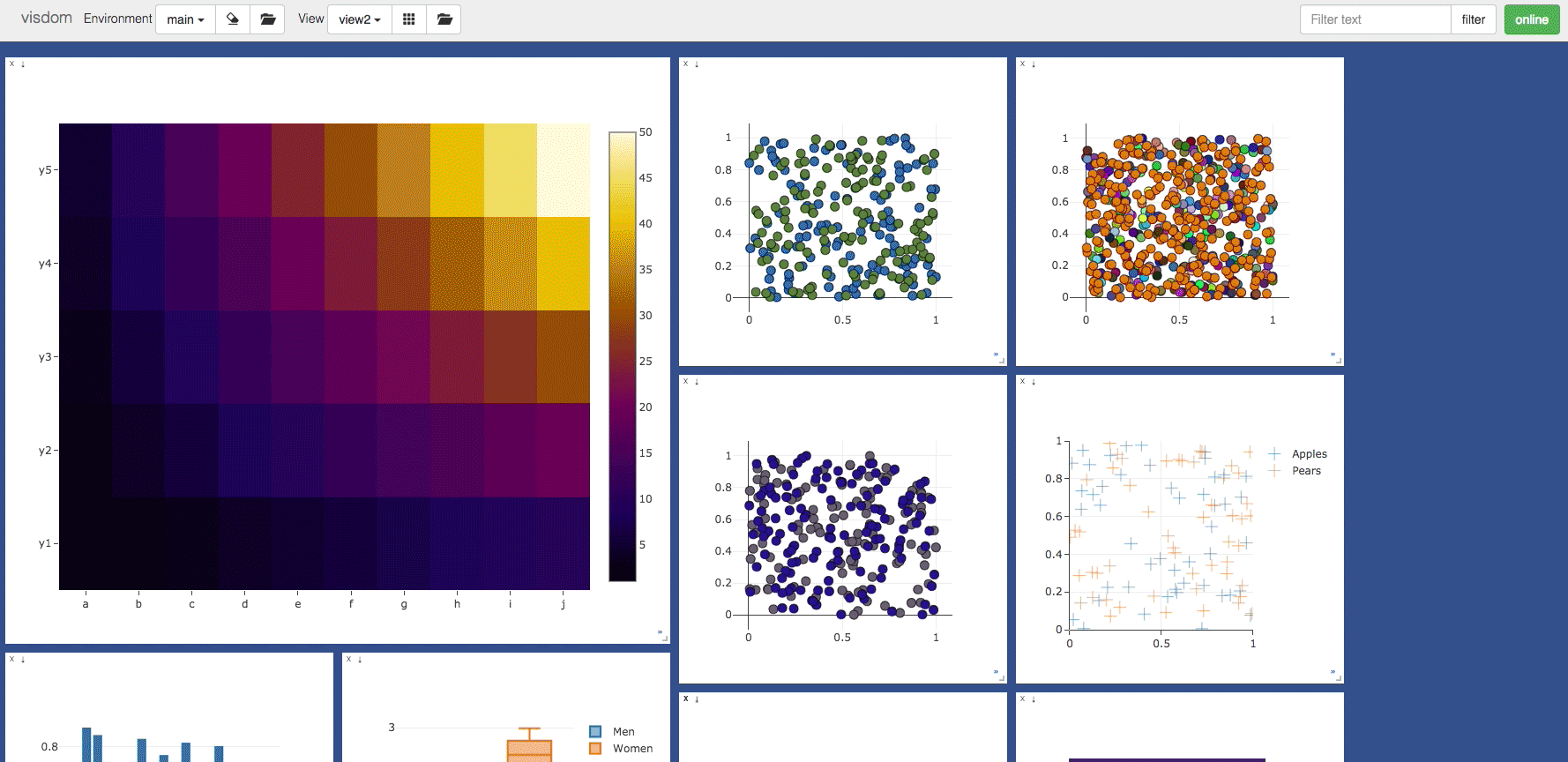
Using the view dropdown it is possible to select previously saved views, restoring the locations and sizes of all of the windows within the current environment to the places they were when that view was saved last.
## Setup
Python and web clients come bundled with the python server.
Install from pip
```bash
> pip install visdom
```
Install from source
```bash
> pip install git+https://github.com/fossasia/visdom
```
## Usage
Start the server (probably in a `screen` or `tmux`) from the command line:
```bash
> visdom
```
Visdom now can be accessed by going to `http://localhost:8097` in your browser, or your own host address if specified.
> The `visdom` command is equivalent to running `python -m visdom.server`.
>If the above does not work, try using an SSH tunnel to your server by adding the following line to your local `~/.ssh/config`:
```LocalForward 127.0.0.1:8097 127.0.0.1:8097```.
#### Command Line Options
The following options can be provided to the server:
1. `-port` : The port to run the server on.
2. `-hostname` : The hostname to run the server on.
3. `-base_url` : The base server url (default = /).
4. `-env_path` : The path to the serialized session to reload.
5. `-logging_level` : Logging level (default = INFO). Accepts both standard text and numeric logging values.
6. `-readonly` : Flag to start server in readonly mode.
7. `-enable_login` : Flag to setup authentication for the sever, requiring a username and password to login.
8. `-force_new_cookie` : Flag to reset the secure cookie used by the server, invalidating current login cookies.
Requires `-enable_login`.
9. `-bind_local` : Flag to make the server accessible only from localhost.
10. `-eager_data_loading` : By default visdom loads environments lazily upon user request. Setting this flag lets visdom pre-fetch all environments upon startup.
When `-enable_login` flag is provided, the server asks user to input credentials using terminal prompt. Alternatively,
you can setup `VISDOM_USE_ENV_CREDENTIALS` env variable, and then provide your username and password via
`VISDOM_USERNAME` and `VISDOM_PASSWORD` env variables without manually interacting with the terminal. This setup
is useful in case if you would like to launch `visdom` server from bash script, or from Jupyter notebook.
```bash
VISDOM_USERNAME=username
VISDOM_PASSWORD=password
VISDOM_USE_ENV_CREDENTIALS=1 visdom -enable_login
```
You can also use `VISDOM_COOKIE` variable to provide cookies value if the cookie file wasn't generated, or the
flag `-force_new_cookie` was set.
#### Python example
```python
import visdom
import numpy as np
vis = visdom.Visdom()
vis.text('Hello, world!')
vis.image(np.ones((3, 10, 10)))
```
### Demos
If you have cloned this repository, you can run our demo showcase.
```bash
python example/demo.py
```
## API
For a quick introduction into the capabilities of `visdom`, have a look at the `example` directory, or read the details below.
### Visdom Arguments (Python only)
The python visdom client takes a few options:
- `server`: the hostname of your visdom server (default: `'http://localhost'`)
- `port`: the port for your visdom server (default: `8097`)
- `base_url`: the base visdom server url (default: `/`)
- `env`: Default environment to plot to when no `env` is provided (default: `main`)
- `raise_exceptions`: Raise exceptions upon failure rather than printing them (default: `True` (soon))
- `log_to_filename`: If not none, log all plotting and updating events to the given file (append mode) so that they can be replayed later using `replay_log` (default: `None`)
- `use_incoming_socket`: enable use of the socket for receiving events from the web client, allowing user to register callbacks (default: `True`)
- `http_proxy_host`: Deprecated. Use Proxies argument for complete proxy support.
- `http_proxy_port`: Deprecated. Use Proxies argument for complete proxy support.
- `username`: username to use for authentication, if server started with `-enable_login` (default: `None`)
- `password`: password to use for authentication, if server started with `-enable_login` (default: `None`)
- `proxies`: Dictionary mapping protocol to the URL of the proxy (e.g. {`http`: `foo.bar:3128`}) to be used on each Request. (default: `None`)
- `offline`: Flag to run visdom in offline mode, where all requests are logged to file rather than to the server. Requires `log_to_filename` is set. In offline mode, all visdom commands that don't create or update plots will simply return `True`. (default: `False`)
Other options are either currently unused (endpoint, ipv6) or used for internal functionality.
### Basics
Visdom offers the following basic visualization functions:
- [`vis.image`](#visimage) : image
- [`vis.images`](#visimages) : list of images
- [`vis.text`](#vistext) : arbitrary HTML
- [`vis.properties`](#visproperties) : properties grid
- [`vis.audio`](#visaudio) : audio
- [`vis.video`](#visvideo) : videos
- [`vis.svg`](#vissvg) : SVG object
- [`vis.matplot`](#vismatplot) : matplotlib plot
- [`vis.save`](#vissave) : serialize state server-side
### Plotting
We have wrapped several common plot types to make creating basic visualizations easily. These visualizations are powered by [Plotly](https://plot.ly/).
The following API is currently supported:
- [`vis.scatter`](#visscatter) : 2D or 3D scatter plots
- [`vis.line`](#visline) : line plots
- [`vis.stem`](#visstem) : stem plots
- [`vis.heatmap`](#visheatmap) : heatmap plots
- [`vis.bar`](#visbar) : bar graphs
- [`vis.histogram`](#vishistogram) : histograms
- [`vis.boxplot`](#visboxplot) : boxplots
- [`vis.surf`](#vissurf) : surface plots
- [`vis.contour`](#viscontour) : contour plots
- [`vis.quiver`](#visquiver) : quiver plots
- [`vis.mesh`](#vismesh) : mesh plots
- [`vis.dual_axis_lines`](#visdual_axis_lines) : double y axis line plots
### Generic Plots
Note that the server API adheres to the Plotly convention of `data` and `layout` objects, such that you can produce your own arbitrary `Plotly` visualizations:
```python
import visdom
vis = visdom.Visdom()
trace = dict(x=[1, 2, 3], y=[4, 5, 6], mode="markers+lines", type='custom',
marker={'color': 'red', 'symbol': 104, 'size': "10"},
text=["one", "two", "three"], name='1st Trace')
layout = dict(title="First Plot", xaxis={'title': 'x1'}, yaxis={'title': 'x2'})
vis._send({'data': [trace], 'layout': layout, 'win': 'mywin'})
```
### Others
- [`vis.close`](#visclose) : close a window by id
- [`vis.delete_env`](#visdelete_env) : delete an environment by env_id
- [`vis.win_exists`](#viswin_exists) : check if a window already exists by id
- [`vis.get_env_list`](#visget_env_list) : get a list of all of the environments on your server
- [`vis.get_window_data`](#visget_window_data): get current data for a window
- [`vis.check_connection`](#vischeck_connection): check if the server is connected
- [`vis.replay_log`](#visreplay_log): replay the actions from the provided log file
## Details

### Basics
#### vis.image
This function draws an `img`. It takes as input an `CxHxW` tensor `img`
that contains the image.
The following `opts` are supported:
- `jpgquality`: JPG quality (`number` 0-100). If defined image will be saved as JPG to reduce file size. If not defined image will be saved as PNG.
- `caption`: Caption for the image
- `store_history`: Keep all images stored to the same window and attach a slider to the bottom that will let you select the image to view. You must always provide this opt when sending new images to an image with history.
> **Note** You can use alt on an image pane to view the x/y coordinates of the cursor. You can also ctrl-scroll to zoom, alt scroll to pan vertically, and alt-shift scroll to pan horizontally. Double click inside the pane to restore the image to default.
#### vis.images
This function draws a list of `images`. It takes an input `B x C x H x W` tensor or a `list of images` all of the same size. It makes a grid of images of size (B / nrow, nrow).
The following arguments and `opts` are supported:
- `nrow`: Number of images in a row
- `padding`: Padding around the image, equal padding around all 4 sides
- `opts.jpgquality`: JPG quality (`number` 0-100). If defined image will be saved as JPG to reduce file size. If not defined image will be saved as PNG.
- `opts.caption`: Caption for the image
#### vis.text
This function prints text in a box. You can use this to embed arbitrary HTML.
It takes as input a `text` string.
No specific `opts` are currently supported.
#### vis.properties
This function shows editable properties in a pane. Properties are expected to be a List of Dicts e.g.:
```
properties = [
{'type': 'text', 'name': 'Text input', 'value': 'initial'},
{'type': 'number', 'name': 'Number input', 'value': '12'},
{'type': 'button', 'name': 'Button', 'value': 'Start'},
{'type': 'checkbox', 'name': 'Checkbox', 'value': True},
{'type': 'select', 'name': 'Select', 'value': 1, 'values': ['Red', 'Green', 'Blue']},
]
```
Supported types:
- text: string
- number: decimal number
- button: button labeled with "value"
- checkbox: boolean value rendered as a checkbox
- select: multiple values select box
- `value`: id of selected value (zero based)
- `values`: list of possible values
Callback are called on property value update:
- `event_type`: `"PropertyUpdate"`
- `propertyId`: position in the `properties` list
- `value`: new value
No specific `opts` are currently supported.
#### vis.audio
This function plays audio. It takes as input the filename of the audio
file or an `N` tensor containing the waveform (use an `Nx2` matrix for stereo
audio). The function does not support any plot-specific `opts`.
The following `opts` are supported:
- `opts.sample_frequency`: sample frequency (`integer` > 0; default = 44100)
Known issue: Visdom uses scipy to convert tensor inputs to wave files. Some
versions of Chrome are known not to play these wave files (Firefox and Safari work fine).
#### vis.video
This function plays a video. It takes as input the filename of the video
`videofile` or a `LxHxWxC`-sized
`tensor` containing all the frames of the video as input. The
function does not support any plot-specific `opts`.
The following `opts` are supported:
- `opts.fps`: FPS for the video (`integer` > 0; default = 25)
Note: Using `tensor` input requires that ffmpeg is installed and working.
Your ability to play video may depend on the browser you use: your browser has
to support the Theano codec in an OGG container (Chrome supports this).
#### vis.svg
This function draws an SVG object. It takes as input a SVG string `svgstr` or
the name of an SVG file `svgfile`. The function does not support any specific
`opts`.
#### vis.matplot
This function draws a Matplotlib `plot`. The function supports
one plot-specific option: `resizable`.
> **Note** When set to `True` the plot is resized with the
pane. You need `beautifulsoup4` and `lxml`
packages installed to use this option.
> **Note**: `matplot` is not rendered using the same backend as plotly plots, and is somewhat less efficient. Using too many matplot windows may degrade visdom performance.
#### vis.plotlyplot
This function draws a Plotly `Figure` object. It does not explicitly take options as it assumes you have already explicitly configured the figure's `layout`.
> **Note** You must have the `plotly` Python package installed to use this function. It can typically be installed by running `pip install plotly`.
#### vis.embeddings
This function visualizes a collection of features using the [Barnes-Hut t-SNE algorithm](https://github.com/lvdmaaten/bhtsne).
The function accepts the following arguments:
- `features`: a list of tensors
- `labels`: a list of corresponding labels for the tensors provided for `features`
- `data_getter=fn`: (optional) a function that takes as a parameter an index into the features array and returns a summary representation of the tensor. If this is set, `data_type` must also be set.
- `data_type=str`: (optional) currently the only acceptable value here is `"html"`
We currently assume that there are no more than 10 unique labels, in the future we hope to provide a colormap in opts for other cases.
From the UI you can also draw a lasso around a subset of features. This will rerun the t-SNE visualization on the selected subset.
#### vis.save
This function saves the `envs` that are alive on the visdom server. It takes input a list of env ids to be saved.
### Plotting
Further details on the wrapped plotting functions are given below.
The exact inputs into the plotting functions vary, although most of them take as input a tensor `X` than contains the data and an (optional) tensor `Y` that contains optional data variables (such as labels or timestamps). All plotting functions take as input an optional `win` that can be used to plot into a specific window; each plotting function also returns the `win` of the window it plotted in. One can also specify the `env` to which the visualization should be added.
#### vis.scatter
This function draws a 2D or 3D scatter plot. It takes as input an `Nx2` or
`Nx3` tensor `X` that specifies the locations of the `N` points in the
scatter plot. An optional `N` tensor `Y` containing discrete labels that
range between `1` and `K` can be specified as well -- the labels will be
reflected in the colors of the markers.
`update` can be used to efficiently update the data of an existing plot. Use `'append'` to append data, `'replace'` to use new data, or `'remove'` to remove the trace specified by `name`.
Using `update='append'` will create a plot if it doesn't exist and append to the existing plot otherwise.
If updating a single trace, use `name` to specify the name of the trace to be updated. Update data that is all NaN is ignored (can be used for masking update).
The following `opts` are supported:
- `opts.markersymbol` : marker symbol (`string`; default = `'dot'`)
- `opts.markersize` : marker size (`number`; default = `'10'`)
- `opts.markercolor` : color per marker. (`torch.*Tensor`; default = `nil`)
- `opts.markerborderwidth`: marker border line width (`float`; default = 0.5)
- `opts.legend` : `table` containing legend names
- `opts.textlabels` : text label for each point (`list`: default = `None`)
- `opts.layoutopts` : dict of any additional options that the graph backend accepts for a layout. For example `layoutopts = {'plotly': {'legend': {'x':0, 'y':0}}}`.
- `opts.traceopts` : dict mapping trace names or indices to dicts of additional options that the graph backend accepts. For example `traceopts = {'plotly': {'myTrace': {'mode': 'markers'}}}`.
- `opts.webgl` : use WebGL for plotting (`boolean`; default = `false`). It is faster if a plot contains too many points. Use sparingly as browsers won't allow more than a couple of WebGL contexts on a single page.
`opts.markercolor` is a Tensor with Integer values. The tensor can be of size `N` or `N x 3` or `K` or `K x 3`.
- Tensor of size `N`: Single intensity value per data point. 0 = black, 255 = red
- Tensor of size `N x 3`: Red, Green and Blue intensities per data point. 0,0,0 = black, 255,255,255 = white
- Tensor of size `K` and `K x 3`: Instead of having a unique color per data point, the same color is shared for all points of a particular label.
#### vis.sunburst
This function draws a sunburst chart. It takes two inputs: `parents` and `labels` array.
values from `parents` array is used as parents object, like it define above which sector
should the this sector shown. values from `labels` array is used to define sector's label
or you can say name. keep in mind that lenght of array `parents` and `labels` should be
equal. There is a third array that you can pass to which is `value`, it is use to show
a value on hovering over a sector, it is optional argument, but if you are passing it then
keep in mind lenght of `values` should be equal to `parents` or `labels`.
Following `opts` are currently supported:
- `opts.font_size` : define font size of label (`int`)
- `opts.font_color` : define font color of label (`string`)
- `opts.opacity` : define opacity of chart (`float`)
- `opts.line_width` : define distance between two sectors and sector to its parents (`int`)
#### vis.line
This function draws a line plot. It takes as input an `N` or `NxM` tensor
`Y` that specifies the values of the `M` lines (that connect `N` points)
to plot. It also takes an optional `X` tensor that specifies the
corresponding x-axis values; `X` can be an `N` tensor (in which case all
lines will share the same x-axis values) or have the same size as `Y`.
`update` can be used to efficiently update the data of an existing plot. Use 'append' to append data, 'replace' to use new data, or 'remove' to remove the trace specified by `name`. If updating a single trace, use `name` to specify the name of the trace to be updated. Update data that is all NaN is ignored (can be used for masking update).
**Smoothing**: Line plots can be smoothened using [Savitzky-Golay filtering](https://en.wikipedia.org/wiki/Savitzky%E2%80%93Golay_filter). This feature can be enabled by clicking the `~`-symbol in the top right corner of a window that contains a line plot.
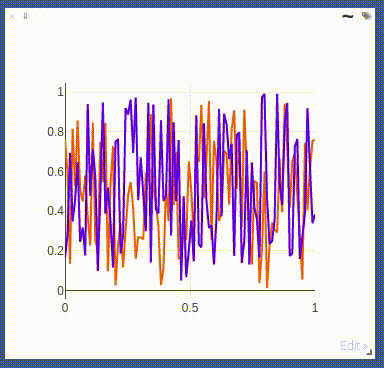
The following `opts` are supported:
- `opts.fillarea` : fill area below line (`boolean`)
- `opts.markers` : show markers (`boolean`; default = `false`)
- `opts.markersymbol`: marker symbol (`string`; default = `'dot'`)
- `opts.markersize` : marker size (`number`; default = `'10'`)
- `opts.linecolor` : line colors (`np.array`; default = None)
- `opts.dash` : line dash type for each line (`np.array`; default = 'solid'), one of `solid`, `dash`, `dashdot` or `dash`, size should match number of lines being drawn
- `opts.legend` : `table` containing legend names
- `opts.layoutopts` : `dict` of any additional options that the graph backend accepts for a layout. For example `layoutopts = {'plotly': {'legend': {'x':0, 'y':0}}}`.
- `opts.traceopts` : `dict` mapping trace names or indices to `dict`s of additional options that plot.ly accepts for a trace.
- `opts.webgl` : use WebGL for plotting (`boolean`; default = `false`). It is faster if a plot contains too many points. Use sparingly as browsers won't allow more than a couple of WebGL contexts on a single page.
#### vis.stem
This function draws a stem plot. It takes as input an `N` or `NxM` tensor
`X` that specifies the values of the `N` points in the `M` time series.
An optional `N` or `NxM` tensor `Y` containing timestamps can be specified
as well; if `Y` is an `N` tensor then all `M` time series are assumed to
have the same timestamps.
The following `opts` are supported:
- `opts.colormap`: colormap (`string`; default = `'Viridis'`)
- `opts.legend` : `table` containing legend names
- `opts.layoutopts` : `dict` of any additional options that the graph backend accepts for a layout. For example `layoutopts = {'plotly': {'legend': {'x':0, 'y':0}}}`.
#### vis.heatmap
This function draws a heatmap. It takes as input an `NxM` tensor `X` that
specifies the value at each location in the heatmap.
`update` can be used to efficiently update the data of an existing plot. Use 'appendRow' to append data row-wise, 'appendColumn' to append data column-wise, 'prependRow' to prepend data row-wise, 'prependColumn' to prepend data column-wise, 'replace' to use new data, or 'remove' to remove the plot specified by `win`.
The following `opts` are supported:
- `opts.colormap` : colormap (`string`; default = `'Viridis'`)
- `opts.xmin` : clip minimum value (`number`; default = `X:min()`)
- `opts.xmax` : clip maximum value (`number`; default = `X:max()`)
- `opts.columnnames`: `table` containing x-axis labels
- `opts.rownames` : `table` containing y-axis labels
- `opts.layoutopts` : `dict` of any additional options that the graph backend accepts for a layout. For example `layoutopts = {'plotly': {'legend': {'x':0, 'y':0}}}`.
- `opts.nancolor` : color for plotting `NaN`s. If this is `None`, `NaN`s will be plotted as transparent. (`string`; default = `None`)
#### vis.bar
This function draws a regular, stacked, or grouped bar plot. It takes as
input an `N` or `NxM` tensor `X` that specifies the height of each of the
bars. If `X` contains `M` columns, the values corresponding to each row
are either stacked or grouped (depending on how `opts.stacked` is
set). In addition to `X`, an (optional) `N` tensor `Y` can be specified
that contains the corresponding x-axis values.
The following plot-specific `opts` are currently supported:
- `opts.rownames`: `table` containing x-axis labels
- `opts.stacked` : stack multiple columns in `X`
- `opts.legend` : `table` containing legend labels
- `opts.layoutopts` : `dict` of any additional options that the graph backend accepts for a layout. For example `layoutopts = {'plotly': {'legend': {'x':0, 'y':0}}}`.
#### vis.histogram
This function draws a histogram of the specified data. It takes as input
an `N` tensor `X` that specifies the data of which to construct the
histogram.
The following plot-specific `opts` are currently supported:
- `opts.numbins`: number of bins (`number`; default = 30)
- `opts.layoutopts` : `dict` of any additional options that the graph backend accepts for a layout. For example `layoutopts = {'plotly': {'legend': {'x':0, 'y':0}}}`.
#### vis.boxplot
This function draws boxplots of the specified data. It takes as input
an `N` or an `NxM` tensor `X` that specifies the `N` data values of which
to construct the `M` boxplots.
The following plot-specific `opts` are currently supported:
- `opts.legend`: labels for each of the columns in `X`
- `opts.layoutopts` : `dict` of any additional options that the graph backend accepts for a layout. For example `layoutopts = {'plotly': {'legend': {'x':0, 'y':0}}}`.
#### vis.surf
This function draws a surface plot. It takes as input an `NxM` tensor `X`
that specifies the value at each location in the surface plot.
The following `opts` are supported:
- `opts.colormap`: colormap (`string`; default = `'Viridis'`)
- `opts.xmin` : clip minimum value (`number`; default = `X:min()`)
- `opts.xmax` : clip maximum value (`number`; default = `X:max()`)
- `opts.layoutopts` : `dict` of any additional options that the graph backend accepts for a layout. For example `layoutopts = {'plotly': {'legend': {'x':0, 'y':0}}}`.
#### vis.contour
This function draws a contour plot. It takes as input an `NxM` tensor `X`
that specifies the value at each location in the contour plot.
The following `opts` are supported:
- `opts.colormap`: colormap (`string`; default = `'Viridis'`)
- `opts.xmin` : clip minimum value (`number`; default = `X:min()`)
- `opts.xmax` : clip maximum value (`number`; default = `X:max()`)
- `opts.layoutopts` : `dict` of any additional options that the graph backend accepts for a layout. For example `layoutopts = {'plotly': {'legend': {'x':0, 'y':0}}}`.
#### vis.quiver
This function draws a quiver plot in which the direction and length of the
arrows is determined by the `NxM` tensors `X` and `Y`. Two optional `NxM`
tensors `gridX` and `gridY` can be provided that specify the offsets of
the arrows; by default, the arrows will be done on a regular grid.
The following `opts` are supported:
- `opts.normalize`: length of longest arrows (`number`)
- `opts.arrowheads`: show arrow heads (`boolean`; default = `true`)
- `opts.layoutopts` : `dict` of any additional options that the graph backend accepts for a layout. For example `layoutopts = {'plotly': {'legend': {'x':0, 'y':0}}}`.
#### vis.mesh
This function draws a mesh plot from a set of vertices defined in an
`Nx2` or `Nx3` matrix `X`, and polygons defined in an optional `Mx2` or
`Mx3` matrix `Y`.
The following `opts` are supported:
- `opts.color`: color (`string`)
- `opts.opacity`: opacity of polygons (`number` between 0 and 1)
- `opts.layoutopts` : `dict` of any additional options that the graph backend accepts for a layout. For example `layoutopts = {'plotly': {'legend': {'x':0, 'y':0}}}`.
#### vis.dual_axis_lines
This function will create a line plot using plotly with different Y-Axis.
`X` = A numpy array of the range.
`Y1` = A numpy array of the same count as `X`.
`Y2` = A numpy array of the same count as `X`.
The following `opts` are supported:
- `opts.height` : Height of the plot
- `opts.width` : Width of the plot
- `opts.name_y1` : Axis name for Y1 plot
- `opts.name_y2` : Axis name for Y2 plot
- `opts.title` : Title of the plot
- `opts.color_title_y1` : Color of the Y1 axis Title
- `opts.color_tick_y1` : Color of the Y1 axis Ticks
- `opts.color_title_y2` : Color of the Y2 axis Title
- `opts.color_tick_y2` : Color of the Y2 axis Ticks
- `opts.side` : side on which the Y2 tick has to be placed. Has values 'right' or `left`.
- `opts.showlegend` : Display legends (boolean values)
- `opts.top` : Set the top margin of the plot
- `opts.bottom` : Set the bottom margin of the plot
- `opts.right` : Set the right margin of the plot
- `opts.left` : Set the left margin of the plot
This is the image of the output:
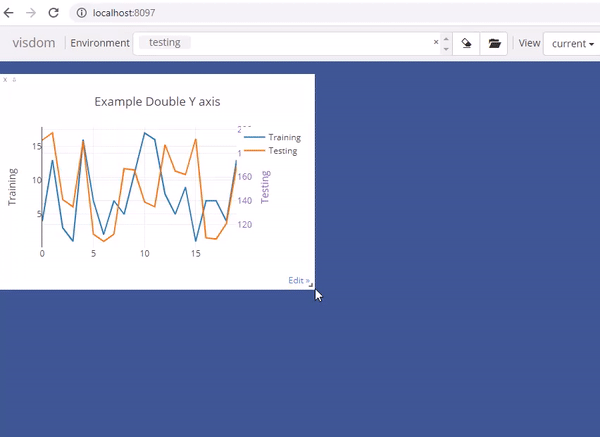
### Network Graph
This function draws a graph, in which the nodes and edges are taken from a 2-D matrix of size [,2] where each row contains a source and destination node value. The numeric value used to define nodes should be strictly between (0 to n-1), where n is the number of nodes.
There are two optional arguments :
- `edgeLabels` : list of custom edge labels. If not provided each edge gets a label, "source-destination", eg "1-2", size should be equal to size of input "edges". Optional.
- `nodeLabels` : list of custom node labels. If not provided each node gets a label same as the numeric value defined in the "edges". size should be equal to number of nodes present. Optional.
The following opts are supported:
- `opts.height` : Height of the plot. Default : 500
- `opts.width` : Width of the plot. Default : 500
- `opts.directed` : whether the plot should have a arrow or not. Default : false
- `opts.showVertexLabels` : Whether to show vertex labels. Default : true
- `opts.showEdgeLabels` : Whether to show edge labels. Default : false
- `opts.scheme` : Whether all nodes shoud have "same" color or "different". Default : "same"
### Customizing plots
The plotting functions take an optional `opts` table as input that can be used to change (generic or plot-specific) properties of the plots.
All input arguments are specified in a single table; the input arguments are matches based on the keys they have in the input table.
The following `opts` are generic in the sense that they are the same for all visualizations (except `plot.image`, `plot.text`, `plot.video`, and `plot.audio`):
- `opts.title` : figure title
- `opts.width` : figure width
- `opts.height` : figure height
- `opts.showlegend` : show legend (`true` or `false`)
- `opts.xtype` : type of x-axis (`'linear'` or `'log'`)
- `opts.xlabel` : label of x-axis
- `opts.xtick` : show ticks on x-axis (`boolean`)
- `opts.xtickmin` : first tick on x-axis (`number`)
- `opts.xtickmax` : last tick on x-axis (`number`)
- `opts.xtickvals` : locations of ticks on x-axis (`table` of `number`s)
- `opts.xticklabels` : ticks labels on x-axis (`table` of `string`s)
- `opts.xtickstep` : distances between ticks on x-axis (`number`)
- `opts.xtickfont` : font for x-axis labels (dict of [font information](https://plot.ly/javascript/reference/#layout-font))
- `opts.ytype` : type of y-axis (`'linear'` or `'log'`)
- `opts.ylabel` : label of y-axis
- `opts.ytick` : show ticks on y-axis (`boolean`)
- `opts.ytickmin` : first tick on y-axis (`number`)
- `opts.ytickmax` : last tick on y-axis (`number`)
- `opts.ytickvals` : locations of ticks on y-axis (`table` of `number`s)
- `opts.yticklabels` : ticks labels on y-axis (`table` of `string`s)
- `opts.ytickstep` : distances between ticks on y-axis (`number`)
- `opts.ytickfont` : font for y-axis labels (dict of [font information](https://plot.ly/javascript/reference/#layout-font))
- `opts.marginleft` : left margin (in pixels)
- `opts.marginright` : right margin (in pixels)
- `opts.margintop` : top margin (in pixels)
- `opts.marginbottom`: bottom margin (in pixels)
`opts` are passed as dictionary in python scripts.You can pass `opts` like:
opts=dict(title="my title", xlabel="x axis",ylabel="y axis")
OR
opts={"title":"my title", "xlabel":"x axis","ylabel":"y axis"}
The other options are visualization-specific, and are described in the
documentation of the functions.
### Others
#### vis.close
This function closes a specific window. It takes input window id `win` and environment id `eid`. Use `win` as `None` to close all windows in an environment.
#### vis.delete_env
This function deletes a specified env entirely. It takes env id `eid` as input.
> **Note**: `delete_env` is deletes all data for an environment and is IRREVERSIBLE. Do not use unless you absolutely want to remove an environment.
#### vis.fork_env
This function forks an environment, similiar to the UI feature.
Arguments:
- `prev_eid`: Environment ID that we want to fork.
- `eid`: New Environment ID that will be created with the fork.
> **Note**: `fork_env` an exception will occur if an env that doesn't exist is forked.
#### vis.win_exists
This function returns a bool indicating whether or not a window `win` exists on the server already. Returns None if something went wrong.
Optional arguments:
- `env`: Environment to search for the window in. Default is `None`.
#### vis.get_env_list
This function returns a list of all of the environments on the server at the time of calling. It takes no arguments.
#### vis.get_window_data
This function returns the window data for the given window. Returns data for all windows in an env if win is None.
Arguments:
- `env`: Environment to search for the window in.
- `win`: Window to return data for. Set to `None` to retrieve all the windows in an environment.
#### vis.check_connection
This function returns a bool indicating whether or not the server is connected. It accepts an optional argument `timeout_seconds` for a number of seconds to wait for the server to come up.
#### vis.replay_log
This function takes the contents of a visdom log and replays them to the current server to restore a state or handle any missing entries.
Arguments:
- `log_filename`: log file to replay the contents of.
## Customizing Visdom
The user config directory for visdom is
- `~/.config/visdom` for Linux
- `~/Library/Preferences/visdom` for OSX
- `%APPDATA%/visdom` for Windows
By placing a `style.css` in you user config directory, visdom will serve the customized css file along with the default style-file.
In addition, it is also possible to create a project-specific file; just place the file `style.css` in your `env_path`.
## License
visdom is Apache 2.0 licensed, as found in the LICENSE file.
## Note on Lua Torch Support
Support for Lua Torch was deprecated following `v0.1.8.4`. If you'd like to use torch support, you'll need to download that release. You can follow the usage instructions there, but it is no longer officially supported.
## Contributing
See guidelines for contributing [here.](./CONTRIBUTING.md)
## Acknowledgments
Visdom was inspired by tools like [display](https://github.com/szym/display) and relies on [Plotly](https://plot.ly/) as a plotting front-end.



